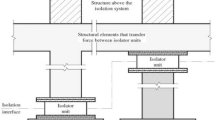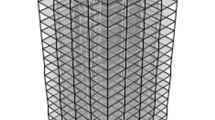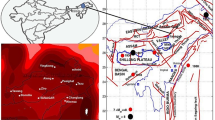Abstract
A synthesis of ground motion and corresponding design response spectrum is presented here. A semi-empirical Green’s function approach based on envelope summation technique is used to model ground motion for evaluation of expected peak ground acceleration (PGA) from future large earthquake in Garhwal Himalaya, northeast (NE) and south India. The synthetic site-specific response spectra for the single degree of freedom (SDOF) structures corresponding to the synthetic ground motion records are obtained for both rock and soil conditions for engineering design of reservoir and nuclear power plant in different parts of India. The predicted PGA for NE India is found to be ~ 3.5 m/s2 at 60 km, decaying to ~ 0.1 m/s2 at 500 km distance, while it is ~ 3.0 m/s2 at 15 km, decaying to ~ 1.4 m/s2 at 80 km distance for Garhwal Himalaya. These PGA estimates are in good agreement with those obtained from the Global Seismic Hazard Assessment Program (GSHAP) exercise. The response spectrum attains its maximum relatively earlier for rock site than for soil site. The response spectra decay gradually at periods later than 0.5 s and approach asymptotically constant values at longer periods. The synthetic ground motions are used to perform seismic response analysis of engineering structures. For such analysis, a PGA of 0.027 g is estimated for the Tail pond reservoir in south India for a target earthquake of M 6.5 at 50 km distance, while a PGA of 0.015 g is found for the Gorakhpur nuclear power plant in north India for similar magnitude and distance. The difference in the PGA estimates between the two is mostly attributed to regional difference in attenuation and site response. The findings of this study are expected to facilitate the seismic design of engineered structures, safe from seismic hazard, in regions where strong motion data are sparse.








Similar content being viewed by others
References
Abrahamson NA, Litehiser JJ (1989) Attenuation of vertical peak acceleration. Bull Seismol Soc Am 79:549–580
Antolik M, Dreger DS (2003) Rupture process of the 26 January 2001 Mw 7.6 Bhuj, India, earthquake from teleseismic broadband data. Bull Seismol Soc Am 93:1235–1248
Atkinson G, Boore D (1995) New ground motion relations for eastern north America. Bull Seismol Soc Am 85:17–30
Bhatia SC, Ravi Kumar M, Gupta HK (1999) A probabilistic hazard map of India and adjoining regions. Ann Geofis 42:1153–1164
Blaser KLF, Ohrnberger M, Scherbaum F (2010) Scaling relations of earthquake source parameter estimates with special focus on subduction environment. Bull Seismol Soc Am 100(6):2914–2926
Boatwright J (1978) Detailed spectral analysis of two small New York State earthquakes. Bull Seismol Soc Am 68:1117–1131
Boore DM (1983) Stochastic simulation of high frequency ground motion based on seismological models of radiated spectra. Bull Seismol Soc Am 73:1865–1894
Boore DM, Atkinson CM (1987) Stochastic prediction of ground motion and spectral response parameters at hard rock sites in eastern North America. Bull Seismol Soc Am 77:440–467
Boore DM, Joyner WB (1991) Estimation of ground motion at deep soil sites in eastern North America. Bull Seismol Soc Am 81:2167–2185
Boore DM, Joyner WB (1997) Site amplifications for generic rock sites. Bull Seismol Soc Am 87:327–341
Brune JN (1970) Tectonic stress and spectra of seismic shear waves from earthquakes. J Geophys Res 75:4997–5009
Campbell KW (1985) Strong motion attenuation relations: a ten-year perspective. Earthquake Spectra 1:759–803
Fletcher JB (1980) Spectra from high-dynamic range digital recordings of Oroville, California, aftershocks and their source parameters. Bull Seismol Soc Am 70:735–755
Garcia D, Singh SK, Herraiz M, Ordaz M, Pacheco JF (2005) Inslab earthquakes of Central Mexico: peak ground-motion parameters and response spectra. Bull Seismol Soc Am 95(6):2272–2282
Gupta SC, Kumar A (2002) Seismic wave attenuation characteristics of three Indian regions: a comparative study. Curr Sci 82(4):407–412
Hutchings L, Ioannidou E, Foxall W, Voulgaris N, Savy J, Kalogeras I, Scognamiglio L, Stavrakakis G (2007) A physically based strong ground-motion prediction methodology; application to PSHA and the 1999 Mw = 6.0 Athens earthquake. Geophy J Int 168:659–680
Irikura K (1986) Prediction of strong acceleration motions using empirical Green’s function. Proc 7th Japan Earthquake Engineering Symp 151–156
Irikura K, Kamae K (1994) Estimation of strong ground motion in broad frequency band based on a seismic source scaling model and an empirical Green’s function technique. Annali di GeoFisicaXXXVII 1721–1743
Irikura K, Kagawa T, Sekiguchi H (1997) Revision of the empirical Green’s function methods by Irikura (1986), Programme and Abstracts. Seismol Soc Jpn 1997(2):B25
Irikura K, Muramatu I (1982) Synthesis of strong ground motion from large earthquake using observed seismograms of small events. Proceedings of the 3rd International Microzonation Conference, Seattle, pp. 447–458
Iyengar RN, Raghukanth STG (2004) Attenuation of strong ground motion in Peninsular India. Seismol Res Lett 75(4):530–540
Joshi A (2001) Strong motion envelope modelling of the source of the Chamoli earthquake of March 28, 1999 in the Garhwal Himalaya, India. J Seismol 5(4):499–518
Joshi A, Kumar B, Sinvhal A, Sinvhal H (1999) Generation of synthetic accelerograms by modelling of rupture plane. ISET J Earthq Technol, paper 390 36(1):43–60
Joshi A, Singh S, Giroti K (2001) The simulation of ground motions using envelope summations. Pure Appl Geophys 158:877–901
Joshi A, Midorikawa S (2004) A simplified method for simulation of strong ground motion using finite rupture model of the earthquake source. J Seismol 8:467–484
Joshi A, Patel RC (1997) Modelling of active lineaments for predicting possible earthquake scenario around Dehradun, Garheal Himalaya, India. Tectonophysics 283:289–310
Joyner WB, Boore DM (1981) Peak horizontal acceleration and velocity from strong motion records including records from the 1979 Imperial Valley, California, earthquake. Bull Seismol Soc Am 71(6):2011–2038
Kameda H, Sugito M (1978) Prediction of strong earthquake motions by evolutionary process model. Proceed 6th Japan Earthq Eng Symp: 41–48
Kumar D, Khattri KN, Teotia SS, Rai SS (1999) Modeling of accelerograms for two Himalayan earthquakes using a novel semi-empirical method and estimation of accelerogram for a hypothetical great earthquake in the Himalaya. Curr Sci 76:819–830
Kumar D, Teotia SS, Sriram V (2010) Modelling of strong ground motions from 1991 Uttarkashi, India, earthquake using a hybrid technique. Pure Appl Geophys 168(10):1621–1643
Malhotra PK (2001) Response spectrum of incompatible acceleration, velocity and displacement histories. Earthq Eng Struct Dyn 30(2):279–286
Midorikawa S (1993) Semi-empirical estimation of peak ground acceleration from large earthquakes. Tectonophysics 218:287–295
Miyake H, Iwata T, Irikura K (1999) Strong ground motion simulation and source modeling of the Kagoshima-ken Hokuseibu earthquakes of March 26 (MJMA 6.5) and May 13 (MJMA 6.3), 1997 using empirical Green’s function method. J Seismol Soc Japan 51:431–442
Mohammadioun B, Serva L (2001) Stress drop, slip type, earthquake magnitude, and seismic hazard. Bull Seismol Soc Am 91:694–707
Mohanty WK, Prakash R, Suresh G, Shukla AK, Walling MY, Srivastava JP (2009) Estimation of coda wave attenuation for the national capital region, Delhi, India using local earthquakes. Pure Appl Geophys 166(3):429–449
Molnar P (1988) A review of geophysical constraints on the deep structure of the Tibetan plateau, the Himalaya, and the Karakorum, and their tectonic implications. Phil Trans R Soc Lond A 326:33–88
Motazedian D, Atkinson GM (2005) Stochastic finite fault modeling based on a dynamic corner frequency. Bull Seismol Soc Am 95:995–1010
Nath SK, Thingbaijam KKS, Maiti SK, Nayak A (2012) Ground-motion predictions in Shillong region, Northeast India. J Seismol 16:475–488
Ni J, Barazangi M (1984) Seismo-tectonics of the Himalayan collision zone: geometry of the underthrusting Indian plate beneath the Himalaya. J Geophy Res 89:1147–1163
Oldham RD (1899) Report of the great earthquake of 12th June, 1897. Mem.Geological Society of India, 1–379
Ordaz M, Singh SK (1992) Source spectra and spatial attenuation of seismic waves from Mexican earthquakes, and evidence of amplification in the hill zone of Mexico City. Bull Seismol Soc Am 82:24–43
Padhy S (2009) Inversion of seismogram envelopes using a multiple isotropic scattering model in Garhwal Himalaya. Bull Seismol Soc Am 99:726–740
Padhy S, Subhadra N (2010) Frequency dependant attenuation of P- and S waves in the Northeast India. Geophys J Int 183:1052–1060
Padhy S, Subhadra N (2016) Spectral scaling and seismic efficiency for earthquakes in Northeast India. Bull Seismol Soc Am 106(4):1613–1627
Parvez IA, Gusev AA, Giuliano FP, Petukhin AG (2001) Preliminary determination of the interdependence among strong-motion amplitude, earthquake magnitude and hypocentral distance for the Himalayan region. Geophys J Int 144:577–596
Peishan C, Haitong C (1989) Scaling law and its applications to earthquake statistical relations. Tectonophysics 166:53–72
Poddar MC (1950) The Assam earthquake of 15th August 1950. Indian Minerals 4:167–176
Raghu Kanth STG, Sreelatha S, Dash SK (2008) Ground motion estimation at Guwahati city for an Mw 8.1 earthquake in the Shillong plateau. Tectonophysics 448:98–114
Raghu Kanth STG, Dash SK (2010) Deterministic seismic scenarios for Northeast India. J Seismol 14:143–167
Richter CF (1958) Elementary seismology. W.H. Freeman and Co, San Francisco, USA, p 768
Satyabala SP (1998) Subduction in the Indo-Burman region: is it still active? Geophys Res Let 25:3189–3192
Seeber L, Ambruster JG, Quittmeyer RC (1981) Seismicity and continental subduction in the Himalayan arc. In, Zagros, Hindu-Kush, Himalaya Geodynamic Evolution, (eds.) Gupta, HK, Delany FM, Geodynamic Series (AGU, Washington), 3: 215–242
Sharma ML (1998) Attenuation relationship for estimation of peak ground horizontal acceleration using data from strong-motion arrays in India. Bull Seismol Soc Am 88:1063–1069
Singh RP, Aman A, Prasad YJJ (1996) Attenuation relations for strong seismic ground motion in the Himalayan region. Pure Appl Geophys 147:161–180
Singh SK, Mohanty W, Bansal BK, Roonwal (2002) Ground motion in Delhi form future large/great earthquakes in the central seismic gaps of the Himalayan arc. Bull Seismol Soc Am 92:555–569
Singh C, Basha SK, Shekar M, Chadha RK (2012) Spatial variation of coda wave attenuation in the southern Indian shield and its implications. Geol Acta 10:309–318
Subhadra N, Padhy S, Seshunarayana T, Vijayaraghavan R (2008) Synthesis of expected ground motion using semi-empirical Green’s function approach and its comparison with observed accelerations in Garhwal Himalaya. Indian Minerals 61(3–4):201–212
Subhadra N, Padhy S, Prasad PP, Seshunarayana T (2015) Site-specific ground motion simulation and seismic response analysis for micro-zonation of Nanded City, India. Nat Hazards 78:915–938
Sutar AK, Verma M, Pandey AP, Bansal BK, Prasad PR, Rao PR, Sharma B (2017) Assessment of maximum earthquake potential of the Kopili fault zone in Northeast India and strong ground motion simulation. J Asian Earth Sci 147:439–451
Toro GR, Mcguire RK (1987) An investigation into earthquake ground motion characteristics in eastern north America. Bull Seismol Soc Am 77:468–489
Wang W, Huang RX (2004) Wind energy input to the Ekman layer 1268. J Phys Oceanography 34:1267–1275
Wells DL, Coppersmith KJ (1994) New empirical relationships among magnitude, rupture length, rupture width, rupture area, and surface displacement. Bull Seismol Soc Am 84(4):974–1002
Yu G (1994) Some aspects of earthquake seismology: slip partitioning along major convergent plate boundaries, composite source model for estimation of strong motion and nonlinear soil response modelling, Ph.D. Thesis, University of Nevada, Reno
Yu G, Khattri KN, Anderson JG, Brune JN, Zeng Y (1995) Strong ground motion from the Uttarkashi earthquake, Himalaya, India earthquake: comparison of observation with synthetics using the composite source model. Bull Seismol Soc Am 85:31–50
Acknowledgments
We sincerely thank Prof. Abdullah M. Al-Amri, Editor-in-Chief, Prof. Narasimman Sundararajan, Associate Editor, and two anonymous reviewers for their constructive review comments that improved the quality of the paper. We acknowledge the Department of Science and Technology, Govt. of India, and the Council of Scientific and Industrial Research (CSIR) for the financial support. Subhadra Nampally acknowledges CSIR for providing the Research Associate Fellowship to conduct this work at CSIR-NGRI. Padhy thanks Prof. A. Joshi for valuable discussions on the subject. We thank the Director, CSIR-NGRI, for his kind permission to publish this work.
Author information
Authors and Affiliations
Corresponding author
Rights and permissions
About this article
Cite this article
Nampally, S., Padhy, S., Srinagesh, D. et al. Evaluation of ground motion and site-specific response spectrum for different parts of India by the method of semi-empirical Green’s function. Arab J Geosci 11, 255 (2018). https://doi.org/10.1007/s12517-018-3600-9
Received:
Accepted:
Published:
DOI: https://doi.org/10.1007/s12517-018-3600-9




